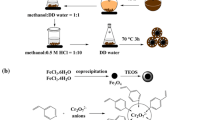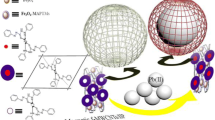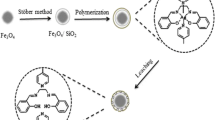Abstract
A novel magnetic ion-imprinted polymer with high accessibility to palladium ions was synthesized via co-precipitation polymerization. Accordingly, a ternary complex composed of PdCl2 as an imprinting ion, 8-aminoquinoline (AQ) as a ligand, and 4-vinyl pyridine (4-VP) as a complexing monomer was applied to Fe3O4@SiO2 as magnetic core, followed by precipitation polymerization using 2-hydroxyethyl methacrylate (2-HEMA) as a co-monomer, ethylene glycol dimethacrylate (EGDMA) as the crosslinker, and 2,2-azobisisobutyronitrile (AIBN) as an initiator in the presence of 2-methoxyethanol as a solvent. The palladium ions were leached out by a solution containing 50% (v/v) HCl. The synthesized polymer was characterized physically and morphologically using different techniques. In order to assess the conditions required for adsorption, as well as the selectivity and reusability, batch adsorption experiments were carried out. The experiments exhibited that the maximum adsorption capacity was about 65.75 mg g−1 at 25 °C, while the pH solution and the adsorbent dose were 4 and 1 g L−1, respectively. Kinetic studies of experimental data demonstrated that they correspond very much to the pseudo-second-order kinetic model. The development of the Langmuir and Freundlich isothermal models on the equilibrium data proved to correspond well to the Langmuir isotherm model. Interferences studies of the magnetic polymer demonstrated higher affinity and discernment for palladium ions than other co-existing ions in the solutions. Spontaneous (ΔG < 0) and exothermic (ΔH < 0) behavior of the adsorption process is confirmed by thermodynamic studies. In addition, the affinity of the spent polymer has not been dramatically reduced over at least five regeneration cycles.















Similar content being viewed by others
References
Azizian S (2004) Kinetic models of sorption: a theoretical analysis. J Colloid Interface Sci 276:47–52
Cui Y, Liu JQ, Hu ZJ, Xua XW, Gaoa HW (2012) Well-defined surface ion-imprinted magnetic microspheres for facile onsite monitoring of lead ions at trace level in water. Anal Methods 4:3095–3097
Daniel S, Babu PEJ, Rao TP (2005a) Preconcentrative separation of palladium(II) using palladium(II) ion-imprinted polymer particles formed with different quinolone derivatives and evaluation of binding parameters based on adsorption isotherm models. Talanta 65:441–452
Daniel S, Rao PP, Rao TP (2005b) TP investigation of different polymerization methods on the analytical performance of palladium (II) ion imprinted polymer materials. Anal Chim Acta 536:197–206
Daniel S, Praveen RS, Rao TP (2006) Ternary ion-association complex based ion imprinted polymers (IIPs) for trace determination of palladium (II) in environmental samples. Anal Chim Acta 570:79–87
Deng Y, Qi D, Deng C, Zhang X, Zhao D, Am J (2008) Superparamagnetic high-magnetization microspHeres with an Fe3O4@SiO2 core and perpendicularly aligned mesoporous SiO2 shell for removal of microcystins. J Am Chem Soc 130:28–29
Djedidi Z, Bouda M, Souissi MA, Ben Cheikh R, Mercier G, Tyagi RD, Blais JF (2009) Metals removal from soil, fly ash and sewage sludge leachates by precipitation and dewatering properties of the generated sludge. J Hazard Mater 172:1372–1382
Ding D, Zhao Y, Yang SI, Shi W, Zhang Z, Lei Z, Yang Y (2013) Adsorption of cesium from aqueous solution using agricultural residue walnut shell: equilibrium, kinetic and thermodynamic modeling studies. Water Res 47:2563–2571
Domanska U, Rekawek A (2009) Extraction of metal ions from aqueous solutions using imidazolium based ionic liquids. J Solut Chem 38:739–751
Ebrahimzadeh H, Moazzen E, Amini MM, Sadeghi O (2013) Novel ion imprinted polymer coated multiwalled carbon nanotubes as a high selective sorbent for determination of gold ions in environmental samples. Chem Eng J 315:215–216
Frantz TS, Silveira N Jr, Quadro MS, Andreazza R, Barcelos AA, Cadaval TRS Jr, Pinto LAA (2017) Cu(II) adsorption from copper mine water by chitosan films and the matrix effects. Environ Sci Pollut Res 24:5908–5917
Freundlich HMF (1906) Uber die adsorption in losungen. Z Phys Chem 57:385–470
Hassanpour S, Taghizadeh M (2016) Rapid and selective separation of molybdenum ions using a novel magnetic Mo(VI) ion imprinted polymer: a study of the adsorption properties. RSC Adv 6:100248–100261
Ho YS, McKay G (1998) Sorption of dye from aqueous solution by peat. Chem Eng J 70:115–124
Iakovleva E, Sillanpää M (2013) The use of low cost adsorbents for wastewater purification in mining industries. Environ Sci Pollut Res 20:7878–7899
Kang YS, Risbud S, Rabolt JF, Stroeve P (1996) Synthesis and characterization of nanometer-size Fe3O4 and γ-Fe2O3 particles. Chem Mater 8:2209–2211
Kazemi E, Haji Shabani AM, Dadfarnia S (2015) Synthesis and characterization of nanomagnetic ion imprinted polymer for selective extraction of silver ions from aqueous sample. Microchim Acta 182:1025–1033
Kumar YP, King P, Prasad VSRK (2007) Adsorption of zinc from aqueous solution using marine green algae-Ulvafasciatasp. Chem Eng J 129:161–166
Langmuir I (1918) The adsorption of gases on plane surfaces of glass, mica and platinum. J Am Chem Soc 40:1361–1403
Liu Y, Liu Z, Gao J, Dai J, Han J, Wang Y, Xie J, Yan Y (2011) Selective adsorption behavior of Pb(II) by mesoporous silica SBA-15-supported Pb(II)-imprinted polymer based on surface molecularly imprinting technique. J Hazard Mater 186:197–205
Monier M, Abdel-Latif DA, Abou El-Reash YG (2016) Ion-imprinted modified chitosan resin for selective removal of Pd(II) ions. J Colloid Interface Sci 469:344–354
Nishide H, Deguchi J, Tsuchida E (1976) Selective adsorption of metal ions on cross-linked poly(vinylpyridine) resin prepared with a metal ion as a template. Chem Lett 5:169–174
Qi X, Gao S, Ding G, Tang AN (2017) Synthesis of surface Cr(VI)-imprinted magnetic nanoparticles for selective dispersive solid-phase extraction and determination of Cr(VI) in water samples. Talanta 162:345–353
Rafati L, Mahvi AH, Asgari AR, Hosseini SS (2010) Removal of chromium(VI) from aqueous solutions using Lewatit FO36 nano ion exchange resin. Int J Environ Sci Technol 7:147–156
Rafatullah M, Sulaiman O, Hashim R, Ahmad A (2009) Adsorption of copper(II), chromium(III), nickel(II) and lead(II) ions from aqueous solutions by meranti sawdust. J Hazard Mater 170:969–977
Ren YM, Wei XZ, Zhang ML (2008) Adsorption character for removal Cu(II) by magnetic Cu(II) ion imprinted composite adsorbent. J Hazard Mater 158:14–22
Sadeghi S, Aboobakri E (2012) Magnetic nanoparticles with an imprinted polymer coating for the selective extraction of uranyl ions. Microchim Acta 178:89–97
Sid Kalal H, Taghiof M, Hoveidi H, Pakizvand N, Vahidi H, Panahi HA, Tavangari S (2013) The pre-concentration and determination of iridium and palladium in environmental water by imprinted polymer-based method. Int J Environ Sci Technol 10:1091–1102
Soylak M, Cay RS (2007) Separation/preconcentration of silver(I) and lead(II) in environmental samples on cellulose nitrate membrane filter prior to their fame atomic absorption spectrometric determinations. J Hazard Mater 146:142–147
Taghizadeh M, Hassanpour S (2017) Selective adsorption of Cr(VI) ions from aqueous solutions using a Cr(VI)-imprinted polymer supported by magnetic multiwall carbon nanotubes. Polymer 132:1–11
Webi TW, Chakravort RK (1974) Pore and solid diffusionmodels for fixed-bed adsorbers. AICHE J 20:228–238
Wu J, Yu HQ (2007) Biosorption of 2, 4-dichlorophenol by immobilized white-rot fungus Phanerochaete chrysosporium from aqueous solutions. Bioresour Technol 98:253–259
Yan MD (2002) Molecularly imprinted polymers as antibody mimics: applications in immunoassays and recent developments. J Clin Ligand Assay 25:234–236
Yan WL, Bai R (2005) Adsorption of lead and humic acid on chitosan hydrogel beads. Water Res 39:688–698
Yu JCC, Lai EPC (2010) Molecularly imprinted polymers for ochratoxin A extraction and analysis. Toxins 2:1536–1553
Zhan Y, Luo X, Nie S, Huang Y, Tu X, Luo S (2011) Selective separation of Cu(II) from aqueous solution with a novel Cu(II) surface magnetic ion-imprinted polymers. Ind Eng Chem Res 50:6355–6361
Zhang ML, Zhang ZH, Liu YN, Yang X, Luo LJ, Chen JT, Yao SZ (2011) Preparation of core–shell magnetic ion-imprinted polymer for selective extraction of Pb(II) from environmental samples. Chem Eng J 178:443–450
Zheng H, Zhang D, Wang WY, Fan YQ, Li J, Han HP (2007) Highly selective determination of palladium(II) after preconcentration using Pd (II)-imprinted functionalized silica gel sorbent prepared by a surface imprinting technique. Microchim Acta 157:7–11
Funding
The authors wish to thank the Iranian Nanotechnology Initiative Council for the financial support of the project. The authors also acknowledge the funding support of Babol Noshirvani University of Technology through Grant Program No. BNUT/370152/97.
Author information
Authors and Affiliations
Corresponding author
Additional information
Responsible editor: Tito Roberto Cadaval Jr
Publisher’s note
Springer Nature remains neutral with regard to jurisdictional claims in published maps and institutional affiliations.
Rights and permissions
About this article
Cite this article
Shafizadeh, F., Taghizadeh, M. & Hassanpour, S. Preparation of a novel magnetic Pd(II) ion-imprinted polymer for the fast and selective adsorption of palladium ions from aqueous solutions. Environ Sci Pollut Res 26, 18493–18508 (2019). https://doi.org/10.1007/s11356-019-05233-8
Received:
Accepted:
Published:
Issue Date:
DOI: https://doi.org/10.1007/s11356-019-05233-8




